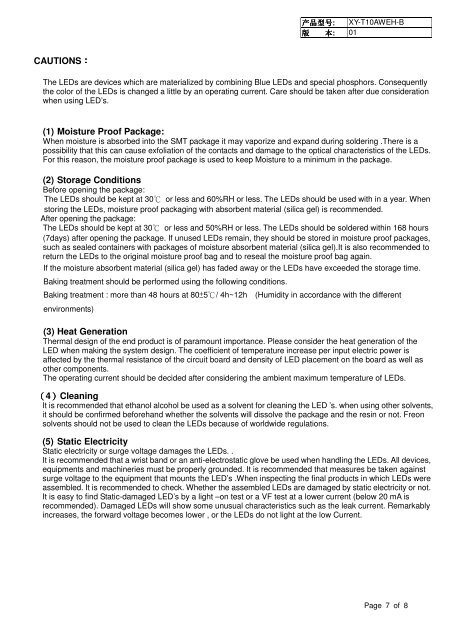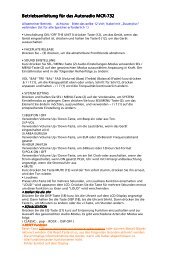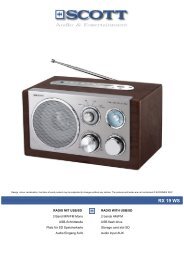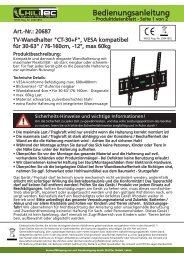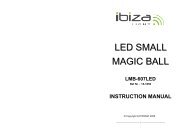DATA SHEET
DATA SHEET
DATA SHEET
You also want an ePaper? Increase the reach of your titles
YUMPU automatically turns print PDFs into web optimized ePapers that Google loves.
CAUTIONS:<br />
产品型号 产品型号: 产品型号 XY-T10AWEH-B<br />
版 本: 01<br />
The LEDs are devices which are materialized by combining Blue LEDs and special phosphors. Consequently<br />
the color of the LEDs is changed a little by an operating current. Care should be taken after due consideration<br />
when using LED’s.<br />
(1) Moisture Proof Package:<br />
When moisture is absorbed into the SMT package it may vaporize and expand during soldering .There is a<br />
possibility that this can cause exfoliation of the contacts and damage to the optical characteristics of the LEDs.<br />
For this reason, the moisture proof package is used to keep Moisture to a minimum in the package.<br />
(2) Storage Conditions<br />
Before opening the package:<br />
The LEDs should be kept at 30℃ or less and 60%RH or less. The LEDs should be used with in a year. When<br />
storing the LEDs, moisture proof packaging with absorbent material (silica gel) is recommended.<br />
After opening the package:<br />
The LEDs should be kept at 30℃ or less and 50%RH or less. The LEDs should be soldered within 168 hours<br />
(7days) after opening the package. If unused LEDs remain, they should be stored in moisture proof packages,<br />
such as sealed containers with packages of moisture absorbent material (silica gel).It is also recommended to<br />
return the LEDs to the original moisture proof bag and to reseal the moisture proof bag again.<br />
If the moisture absorbent material (silica gel) has faded away or the LEDs have exceeded the storage time.<br />
Baking treatment should be performed using the following conditions.<br />
Baking treatment : more than 48 hours at 80±5℃/ 4h~12h (Humidity in accordance with the different<br />
environments)<br />
(3) Heat Generation<br />
Thermal design of the end product is of paramount importance. Please consider the heat generation of the<br />
LED when making the system design. The coefficient of temperature increase per input electric power is<br />
affected by the thermal resistance of the circuit board and density of LED placement on the board as well as<br />
other components.<br />
The operating current should be decided after considering the ambient maximum temperature of LEDs.<br />
(4)Cleaning<br />
It is recommended that ethanol alcohol be used as a solvent for cleaning the LED ’s. when using other solvents,<br />
it should be confirmed beforehand whether the solvents will dissolve the package and the resin or not. Freon<br />
solvents should not be used to clean the LEDs because of worldwide regulations.<br />
(5) Static Electricity<br />
Static electricity or surge voltage damages the LEDs. .<br />
It is recommended that a wrist band or an anti-electrostatic glove be used when handling the LEDs. All devices,<br />
equipments and machineries must be properly grounded. It is recommended that measures be taken against<br />
surge voltage to the equipment that mounts the LED’s .When inspecting the final products in which LEDs were<br />
assembled. It is recommended to check. Whether the assembled LEDs are damaged by static electricity or not.<br />
It is easy to find Static-damaged LED’s by a light –on test or a VF test at a lower current (below 20 mA is<br />
recommended). Damaged LEDs will show some unusual characteristics such as the leak current. Remarkably<br />
increases, the forward voltage becomes lower , or the LEDs do not light at the low Current.<br />
Page 7 of 8


